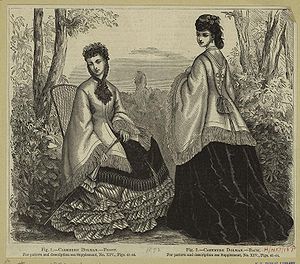
Mantle (clothing)
Encyclopedia

- For the native American shield, see Mantelet (shield).
A mantle (from mantellum, the Latin term for a cloak
Cloak
A cloak is a type of loose garment that is worn over indoor clothing and serves the same purpose as an overcoat; it protects the wearer from the cold, rain or wind for example, or it may form part of a fashionable outfit or uniform. Cloaks are as old as human history; there has nearly always been...
) is a type of loose garment usually worn over indoor clothing
Clothing
Clothing refers to any covering for the human body that is worn. The wearing of clothing is exclusively a human characteristic and is a feature of nearly all human societies...
to serve the same purpose as an overcoat
Overcoat
An overcoat is a type of long coat intended to be worn as the outermost garment. Overcoats usually extend below the knee, but are sometimes mistakenly referred to as topcoats, which are short coats that end at or above the knees. Topcoats and overcoats together are known as outercoats...
. Technically, the term describes a long, loose cape
Cape
Cape can be used to describe any sleeveless outer garment, such as a poncho, but usually it is a long garment that covers only the back half of the wearer, fastening around the neck. They were common in medieval Europe, especially when combined with a hood in the chaperon, and have had periodic...
-like cloak worn from the 12th to the 16th century and during the civil war by both sexes, although by the 19th century, it was used to describe any loose-fitting, shaped woman's outer garment similar to a cape. For example, the dolman
Dolman
A Dolman Originally, the term referred to a long and loose garment with narrow sleeves and an opening in the front. It was worn generally by the Turks, and is not unlike a cassock in shape.-Military dolman:...
, a 19th century cape-like garment with partial sleeves is often described as a mantle.
Mantelets
A variation on the mantle is the mantelet (also spelled mantelot and mantlet), typically describing a short version of the mantle. The term appears as early as 1386, in "The Knight's TaleThe Knight's Tale
"The Knight's Tale" is the first tale from Geoffrey Chaucer's The Canterbury Tales. The story introduces many typical aspects of knighthood such as courtly love and ethical dilemmas. The story is written in iambic pentameter end-rhymed couplets.-Story:...
" by Geoffrey Chaucer
Geoffrey Chaucer
Geoffrey Chaucer , known as the Father of English literature, is widely considered the greatest English poet of the Middle Ages and was the first poet to have been buried in Poet's Corner of Westminster Abbey...
. In the 18th century, a mantelet was a woman's short cloak, and in the early 19th century, it was an ornamental scarf
Scarf
A scarf is a piece of fabric worn around the neck, or near the head or around the waist for warmth, cleanliness, fashion or for religious reasons. They can come in a variety of different colours.-History:...
that crossed over the chest and tied behind, usually made of fur
Fur
Fur is a synonym for hair, used more in reference to non-human animals, usually mammals; particularly those with extensives body hair coverage. The term is sometimes used to refer to the body hair of an animal as a complete coat, also known as the "pelage". Fur is also used to refer to animal...
or lace
Lace
Lace is an openwork fabric, patterned with open holes in the work, made by machine or by hand. The holes can be formed via removal of threads or cloth from a previously woven fabric, but more often open spaces are created as part of the lace fabric. Lace-making is an ancient craft. True lace was...
.. By the end of the 19th century, a mantelet was a woman's shoulder cape with elongated ends in front, sometimes held in position by a belt at the waist.

